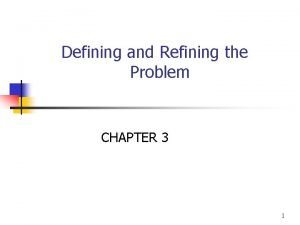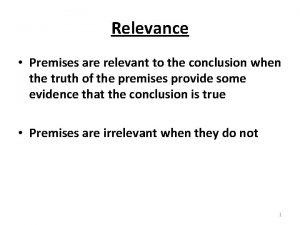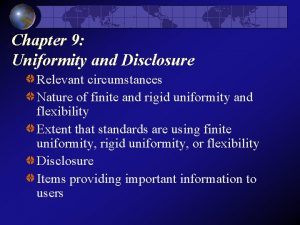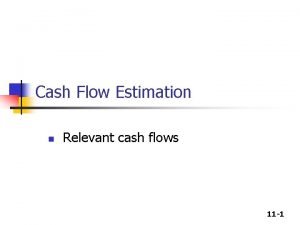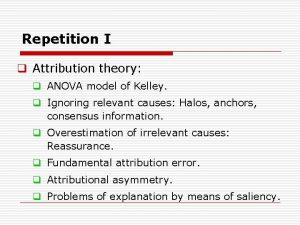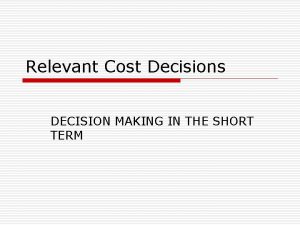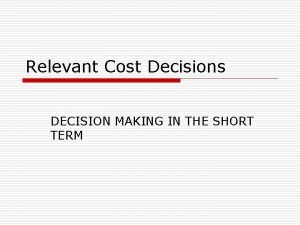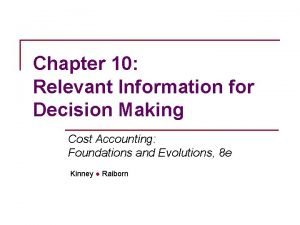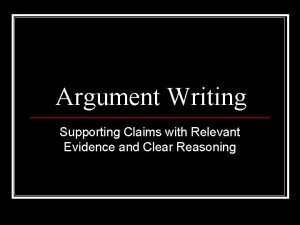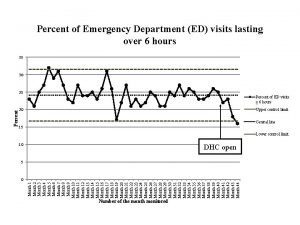Is statistics relevant to you personally Month 1





















































- Slides: 53

Is statistics relevant to you personally? Month 1 Month 2 Bush 42% 41% Dukakis 40% 43% Undecided 18% 16% 4% Headline: Dukakis surges past Bush in polls!

Is statistics relevant to you personally? Global Warming Analytical medical diagnostics Effect of EM radiation

What kinds of things can you measure quantitatively? What kinds of things can you measure qualitatively? What is the difference between a qualitative and quantitative measurement? Which of these types of measurement are important in science? In so far as possible, physics is exact and quantitative … though you will repeatedly see mathematical approximations made to get at the qualitative essence of phenomena.

A quantitative measurement is meaningless without a unit and error.

Accuracy: A measure of closeness to the “truth”. Precision: A measure of reproducibility.

Accuracy vs. precision accurate precise

Types of errors Statistical error: Results from a random fluctuation in the process of measurement. Often quantifiable in terms of “number of measurements or trials”. Tends to make measurements less precise. Systematic error: Results from a bias in the observation due to observing conditions or apparatus or technique or analysis. Tend to make measurements less accurate.

# time True value

Parent distribution (infinite number of measurements) # time True value

The game: From N (not infinite) observations, determine “ ” and the “error on ” … without knowledge of the “truth”. # time True value

The parent distribution can take different shapes, depending on the nature of the measurement. The two most common distributions one sees are the Gaussian and Poisson distributions.

Most probable value Highest on the curve. Most likely to show up in an experiment. Probability or number of counts x

Most probable value Median Value of x where 50% of measurements fall below and 50% of measurements fall above Probability or number of counts x

Most probable value Median Mean or average value of x Probability or number of counts x

The most common distribution one sees (and that which is best for guiding intuition) is the Gaussian distribution. counts x

For this distribution, the most probable value, the median value and the average are all the same due to symmetry. counts x

The most probable estimate of is given by the mean of the distribution of the N observations counts True value, x

counts True value, x

True value, x

Error goes like True value, But this particular quantity “averages” out to zero. Try f( -xi)2 instead. x

The “standard deviation” is a measure of the error in each of the N measurements. True value, x

is unknown. So use the mean (which is your best estimate of ). Change denominator to increase error slightly due to having used the mean. This is the form of the standard deviation you use in practice. This quantity cannot be determined from a single measurement.

Gaussian distribution counts x

Gaussian distribution intuition 1 is roughly half width at half max counts x

Gaussian distribution intuition Probability of a measurement falling within 1 of the mean is 0. 683 counts x

Gaussian distribution intuition Probability of a measurement falling within 2 of the mean is 0. 954 counts x

Gaussian distribution intuition Probability of a measurement falling within 3 of the mean is 0. 997 counts x

Month 1 Month 2 Bush 42% 41% Dukakis 40% 43% Undecided 18% 16% 4% Headline: Dukakis surges past Bush in polls!

The standard deviation is a measure of the error made in each individual measurement. Often you want to measure the mean and the error in the mean. Which should have a smaller error, an individual measurement or the mean? Error in the mean

Numerical example: Some say if Dante were alive now, he would describe hell in terms of taking a university course in physics. One vision brought to mind by some of the comments I’ve heard is that of the devil standing over the pit of hell gleefully dropping young, innocent, and hardworking students into the abyss in order to measure “g”, the acceleration due to gravity.

Student 1: 9. 0 m/s 2 Student 2: 8. 8 m/s 2 Student 3: 9. 1 m/s 2 Student 4: 8. 9 m/s 2 Student 5: 9. 1 m/s 2

Student 1: 9. 0 m/s 2 Student 2: 8. 8 m/s 2 Student 3: 9. 1 m/s 2 Student 4: 8. 9 m/s 2 Student 5: 9. 1 m/s 2

Student 1: 9. 0 m/s 2 Student 2: 8. 8 m/s 2 Student 3: 9. 1 m/s 2 Student 4: 8. 9 m/s 2 Student 5: 9. 1 m/s 2

How does an error in one measurable affect the error in another measurable? y y=F(x) y+ y y 1 y- y X- x x 1 x+ x x

The degree to which an error in one measurable affects the error in another is driven by the functional dependence of the variables (or the slope: dy/dx) y y=F(x) y+ y y 1 y- y X- x x 1 x+ x x

The complication Most physical relationships involve multiple measurables! y = F(x 1, x 2, x 3, …) Must take into account the dependence of the final measurable on each of the contributing quantities.

Partial derivatives What’s the slope of this graph? ? For multivariable functions, one needs to define a “derivative” at each point for each variable that projects out the local slope of the graph in the direction of that variable … this is the “partial derivative”.

Partial derivatives The partial derivative with respect to a certain variable is the ordinary derivative of the function with respect to that variable where all the other variables are treated as constants.

Example

The formula for error propagation If f=F(x, y, z…) and you want f and you have x, y, z …, then use the following formula:

The formula for error propagation If f=F(x, y, z…) and you want f and you have x, y, z …, then use the following formula: Measure of error in x

The formula for error propagation If f=F(x, y, z…) and you want f and you have x, y, z …, then use the following formula: Measure of dependence of F on x

The formula for error propagation If f=F(x, y, z…) and you want f and you have x, y, z …, then use the following formula: Similar terms for each variable, add in quadrature.

Example A pitcher throws a baseball a distance of 30± 0. 5 m at 40± 3 m/s (~90 mph). From this data, calculate the time of flight of the baseball.


Why are linear relationships so important in analytical scientific work? y y=F(x) y 1 x

y y=F(x)=mx+b Is this a good “fit”? x

y y=F(x)=mx+b Is this a good fit? Why? x

y y=F(x)=mx+b Is this a good fit? x

Graphical analysis y pencil and paper still work! y=F(x)=mx+b Slope (m) is rise/run x b is the y-intercept

Graphical determination of error in slope and y-intercept y y=F(x)=mx+b x

Linear regression y With computers: y=F(x)=mx+b Garbage in Garbage out x

Linear regression Hypothesize a line y=F(x)=mx+b
 Tribe of judah
Tribe of judah Sidereal vs synodic month
Sidereal vs synodic month Knowing god personally
Knowing god personally 4 spiritual laws
4 spiritual laws Personally identifiable information pii training 1 hour
Personally identifiable information pii training 1 hour Personally directed play
Personally directed play Introduction to statistics what is statistics
Introduction to statistics what is statistics What is irrelevant sentence example
What is irrelevant sentence example Decision making and relevant information
Decision making and relevant information Relevant cost adalah
Relevant cost adalah Five step decision making process
Five step decision making process Consider all relevant criteria
Consider all relevant criteria Broad problem area
Broad problem area Culturally responsive vs culturally relevant
Culturally responsive vs culturally relevant Select significant and relevant information
Select significant and relevant information Contoh relevant range
Contoh relevant range Affirm the antecedent
Affirm the antecedent The contribution margin
The contribution margin Relevant cost for decision making exercises
Relevant cost for decision making exercises Relevant cost for decision making solution chapter 13
Relevant cost for decision making solution chapter 13 Chapter 11 decision making and relevant information
Chapter 11 decision making and relevant information What is font
What is font Bible is relevant
Bible is relevant Relevant circumstances adalah
Relevant circumstances adalah Chapter 11 decision making and relevant information
Chapter 11 decision making and relevant information Prefetching relevant priors
Prefetching relevant priors Relevant contextual factors
Relevant contextual factors 16 personalities.com/free-personality-test
16 personalities.com/free-personality-test Relevant range managerial accounting
Relevant range managerial accounting Decision making and relevant information
Decision making and relevant information Vague questions examples
Vague questions examples Relevant cash flows definition
Relevant cash flows definition Cash flow estimation
Cash flow estimation Relevant cost in management accounting
Relevant cost in management accounting Pico and finer criteria
Pico and finer criteria Culturally relevant pedagogy
Culturally relevant pedagogy Ecological fallacy
Ecological fallacy Relevant cost
Relevant cost Falling action of mulan
Falling action of mulan Litreature
Litreature Is the constitution still relevant
Is the constitution still relevant Decision making and relevant information
Decision making and relevant information Decision making and relevant information
Decision making and relevant information Incremental cash flows example
Incremental cash flows example Crisis managment plan
Crisis managment plan Relevant information for decision making
Relevant information for decision making Relevant evidence in writing
Relevant evidence in writing Pengertian relevant cost
Pengertian relevant cost New education reforms in sri lanka in sinhala
New education reforms in sri lanka in sinhala You say that you love rain
You say that you love rain Good health is a choice agree or disagree
Good health is a choice agree or disagree If you think you can you can poem
If you think you can you can poem Tell me what you eat and i shall tell you what you are
Tell me what you eat and i shall tell you what you are I will follow you wherever you blank
I will follow you wherever you blank












